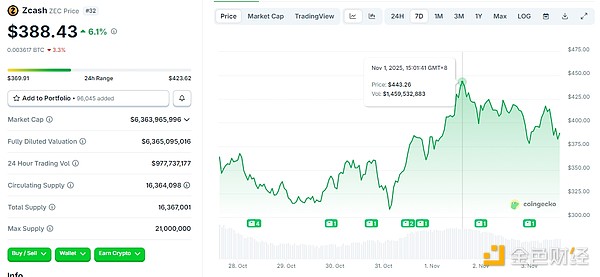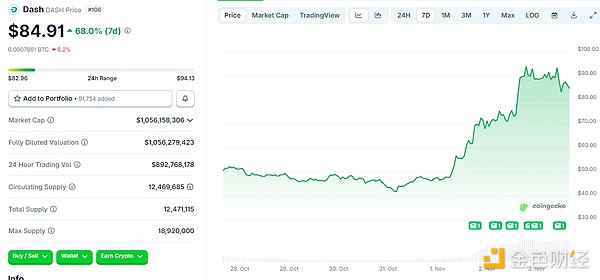Deng Tong, Jinse Finance
Recently, the privacy sector has seen a strong performance, with ZEC rising 6.1% in seven days; DASH rising 68% in seven days; and ZK rising 53.9% in seven days. As of press time, the total market capitalization of privacy coins has exceeded $23.5 billion.

Why have privacy coins recently experienced such a surge? Can this upward trend continue?
I. Privacy Coins Soaring
1. ZEC (Zcash)
ZEC is the native token of the Zcash blockchain network. Zcash is one of the early privacy-focused cryptocurrencies, launched in October 2016.
ZEC reached a recent price high of $443 on November 1st, and as of press time, it is trading at $388.43, a seven-day increase of 6.1%.

The core of Zcash's privacy model is address masking. It uses zero-knowledge proofs (zk-SNARKs) to hide the sender, receiver, and transaction amount.
Transactions sent between shielded addresses go into a pool to hold private transaction tokens. As the pool grows, the network's anonymity set expands, enhancing privacy for all users. This protected pool has now reached its largest size ever, approaching 4.9 million ZEC. The supply of Shielded Zcash is approaching 30%. Source: Zecheb
In early October, Electric Coin Company, the developer of Zcash, launched a new feature for its Zashi wallet, allowing users to perform cross-chain exchanges and private payments through integration with Near Intents' system. This means users can easily transfer funds between Zcash's privacy layers without going through centralized exchanges or complex bridging interfaces.
This newly discovered convenience drove the expansion of the entire protected liquidity pool in October. In early October, Zcash trading activity on Near Intents surged, exceeding $17 million in a single day on October 16th.

Carter Feldman, founder and CEO of Psy Protocol, pointed out: "The focus is shifting to projects that are not issuing tokens for the sake of issuing tokens, but rather those that are building privacy technologies (such as zero-knowledge systems driven by genuine incentive mechanisms). These systems can provide privacy protection by default without requiring users to explicitly choose anonymity."
2. DASH (Dash)
DASH is a veteran privacy-focused cryptocurrency that emerged in 2014.
DASH approached $94 on November 2nd. As of press time, DASH is trading at $84.91, a seven-day increase of 68%.
DASH was trading near $94 on November 2nd.

Dash's resurgence is remarkable, marking a major turnaround for the privacy coin sector. After a prolonged bear market, Dash ended its 968-day decline, which analysts attribute to effective network development initiatives such as "Project Three Billion," aimed at promoting Dash's widespread adoption in underserved markets.
DASH's privacy capabilities stem from its proprietary PrivateSend mixing protocol. This technology anonymizes transactions through a "funds split - mix - recombine" process, requiring only collaboration between the masternode and the official wallet, without relying on third-party services.
DASH's privacy capabilities stem from its proprietary PrivateSend mixing protocol. This technology achieves transaction anonymity through a "funds split - mix - recombine" process, requiring only masternodes and the official wallet to work together, without relying on third-party services.
DASH's core positioning is "decentralized digital cash," aiming to solve the dual pain points of traditional cryptocurrencies in privacy protection and practical payment scenarios. Unlike Bitcoin's open and transparent transactions, DASH meets users' asset confidentiality needs through optional privacy features; compared to privacy coins that focus on technological experiments, it emphasizes "readiness," promoting the large-scale application of cryptocurrencies in offline consumption, cross-border transfers, and other scenarios by optimizing transaction speed and lowering the barrier to entry. This positioning of "privacy protection as the foundation and payment implementation as the core" has led to a revaluation in the market against the backdrop of increasingly stringent global regulations and upgraded payment demands in 2025.
3. ZK (ZKsync)
Unlike traditional privacy coins, ZK is not a token focused on a single privacy function, but rather a core asset that has risen based on the "privacy + scalability + ecosystem" triple attributes of the zkSync network.
ZK reached a recent high of $0.07 on November 2nd. As of press time, ZK is trading at $0.05275, a seven-day increase of 53.9%. ZK's core positioning is as the "value carrier and governance credential" of the zkSync network, aiming to achieve both privacy protection and scalable applications by empowering the Ethereum Layer 2 ecosystem. ZK's upward trend began last Friday when ZKsync founder Alex Gluchowski announced the launch of the Atlas upgrade, highlighting institutional-grade scalability, interoperability, and transaction speed as key features. Gluchowski stated that this update enables Layer-2 protocols to rely on Ethereum for liquidity and new institutional capital inflows during deployment, as well as cross-chain transactions and asset tokenization. Vitalik endorsed zkSync, noting, "ZKsync has done a lot of underrated but very valuable work in the Ethereum ecosystem. It's great to see them launch this product!" "Immutability is Ethereum's most important characteristic." alt="KNyt0Z59uNruaQmyDuf43yrxnESbFKUQNd4qzlZm.jpeg">II. What is driving the surge in privacy coins?
1. Regulatory Driven
Cryptocurrencies are under continuous surveillance, including Know Your Customer (KYC) checks, exchange monitoring, and advanced blockchain analytics. For example, blockchain forensics experts use machine learning to track wallets and build behavioral profiles. Their systems can link identities, map connections between wallets, and predict when assets will be transferred to exchanges.
Governments around the world are also strengthening controls. On August 18, the U.S. Treasury Department solicited public comments on artificial intelligence, blockchain monitoring, digital identity credentials, and "privacy enhancement tools" for detecting illicit activities involving digital assets. The agency stated that these feedbacks will provide a basis for new guidelines and potential rules developed under the GENIUS Act.
In the EU, cryptocurrency exchanges must treat transfers to or from custodial wallets as high-risk transactions and implement stricter due diligence measures, including verifying wallet control. These regulations came into effect on December 30, 2024. As governments weigh the use of invasive tools to monitor online behavior and companies collect more data, privacy technologies are being redefined as a market opportunity. 2. Halving Expectations Coinbase's Head of Investment Research, David Duong, stated that Zcash will undergo a halving in November 2025. With the halving, the issuance of Zcash is expected to decrease significantly, pushing the implied inflation rate down from double digits in the early 2020s to single digits in the late 2020s. ZEC's block reward halves every four years. The current block reward is 3.125 ZEC, and after the next halving, it will drop to 1.5625 ZEC, which is expected to reduce the daily supply by approximately 1500 ZEC. This price movement can be seen as a market reaction to the upcoming halving. 3. Industry Giants Enter the Market In October, a16z's latest crypto report pointed out that privacy protection is returning to the forefront and may become a prerequisite for widespread adoption. Signs of this increased attention include: a surge in Google searches related to crypto privacy in 2025; Zcash's shielded liquidity pool supply growing to nearly 4 million ZEC; and Railgun's monthly transaction volume exceeding $200 million. Meanwhile, the Ethereum Foundation established a new privacy team; Paxos partnered with Aleo to launch a private and compliant stablecoin (USAD); and the Office of Foreign Assets Control lifted sanctions on the decentralized privacy protocol Tornado Cash. We expect this trend to gain even greater momentum in the coming years as crypto technology becomes more mainstream. III. Can the Current Privacy Coin Rally Continue? In October, Hayes made a bullish prediction for ZEC, and the price of Zcash surged from $272 to a peak of $355 within hours. During the same period, the token outperformed all other tokens in the top 50 by market capitalization. Cryptocurrency trader AB Kuai Dong pointed out that the endorsement of a "legendary Silicon Valley investor" prompted "everyone to follow the trend and join in, subsequently triggering a month-long FOMO market frenzy." In the short term, the current privacy coin rally is related to market sentiment, halving expectations, and policy drivers. However, in the long term, real-world application scenarios and policy trends are the fundamental factors determining the privacy coin rally. Currently, privacy coins account for only 11.4% of global cryptocurrency trading, and their market share growth rate is insufficient to significantly impact the overall crypto market. But the underlying technologies—ring signatures, hidden addresses, and zero-knowledge proofs—have the potential to completely change mainstream understanding of financial privacy.
 JinseFinance
JinseFinance
 JinseFinance
JinseFinance JinseFinance
JinseFinance WenJun
WenJun JinseFinance
JinseFinance JinseFinance
JinseFinance JinseFinance
JinseFinance JinseFinance
JinseFinance JinseFinance
JinseFinance JinseFinance
JinseFinance JinseFinance
JinseFinance